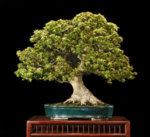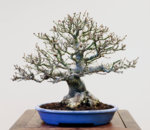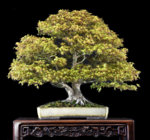Clicio
Masterpiece
Bonsai consists of several phases...and different techniques are used in each..
@Leo in N E Illinois , this is for sure the BEST post ever! Thanks for how much I have just learned from it.
Bonsai consists of several phases...and different techniques are used in each..
I think the argument is simply - there are much easier and faster ways. You can start with young material and still craft it as your own. Take 4-15 years off the clock right away.Whoever says growing from seed is wrong is foolhardy at worst. Whoever says growing from seed is a waste of time has an opinion at best. Bottom line. It can and is being done.






...Some of my best masterpiece pine bonsai have been grown by me for over 45 years from young seedlings completely container grown... it makes no difference if a tree was drastic pruned or grown from a young plant if the total aesthetic impact is present...
I have plenty of photos to back up my life’s passion and work.
The beauty of this tree makes me want to cry.View attachment 222340
Koto Hime Japanese maple
The beauty of this tree makes me want to cry.
First of all, the correct term for removing heavy wood from trees is called “Drastic Pruning” not trunk chop or any variations of that. Bonsai is an elegant art and if we are attempting to elevate this art form, correct language would be best, not by using street language. My teacher, Yuji Yoshimura, taught me to use the correct terminology and to continue along the path I feel is correct and to forget about comments from others. “To your own self be true….”
When evaluating a bonsai the visual total aesthetic impact is the most important element. For serious practioners of bonsai the history and method of creation is important for two reasons. First to respect the decades of care and training which has taken place to shape and keep the trees alive. Second, people learn and study when looking at the trees. But, that’s just learning and has nothing to do about the appreciation of the bonsai form. All people are noton the same level of understanding and appreciation. That’s one important factor to understand.
Next month I’m traveling to Japan, only to see the 93rdKokufu Bonsai Exhibition, where I can study over 500 individual specimens. At first, I’ll be overwhelmed by their beauty but upon second and third, and even fourth viewing I’ll hope to see everything.
In Japan I’ve seen fruit hot glued on bonsai, deadwood added in necessary locations. I’ve even seen an old mature beautiful Japanese maple bonsai, with no apparent large drastic pruning scars. But when I looked closely, I saw a couple of large scars painted to match the aged bark and the artist even paintedbark stripes on the scar. It was a pretty good job. I admired the beauty of the bonsai which was presented to me. And, I also learned a couple of new techniques.
In November I was invited and had the honor and privilege to be one of the 15 judges for the Nippon Bonsai Taikan Exhibition in Kyoto. I was the first American and Westerner to judge at a Japanese bonsai exhibition. I was not told any rules or judging forms, only to select the best bonsai out of a group of three masterpieces. Of course I spent considerable time before the judging process looking all around the trees as they were displayed on long tables where you could actually examine each bonsai.
So the beauty of a bonsai is most important. Not so important is how it was created either from a container grown seedling/cutting/airlayer or drastic pruning a larger tree to obtain a heavier trunk to begin with. In Japan, after years or decades of training, the method used to create the tree is not important. Probably most of the deciduous bonsai in Japan have had large branches removed and the scars are now completely covered with new bark. One can’t really determine this through photos, especially on the internet. One really needs to see the bonsai in person. I actually have been to Japan to study their bonsai, well over 50 times, five time in 2017 alone.
I wonder what people think of the large massive Sargent juniper bonsai in Japan where every branch has been grafted in the exact perfect location. This also is the case for Japanese flowering apricots. Of course this type of grafting is used to change desired varieties as well. But this type of bonsai creation requires many years of development and growing by skilled artists who understand and know the necessary techniques.
Of course I have several deciduous bonsai masterpieces I created by drastic pruning larger material. I also have several started from seed, completely container grown as well as from airlayers, grafts and cuttings as well. Some of my best masterpiece pine bonsai have been grown by me for over 45 years from young seedlings completely container grown.
In my learned opinion after studying bonsai for over 50 years both in Japan and the United States; and having judged bonsai in Japan as well as China, it makes no difference if a tree was drastic pruned or grown from a young plant if the total aesthetic impact is present. I have plenty of photos to back up my life’s passion and work. Just ask.
View attachment 222338
RAF Dearf Scots pine, container grown and trained for over 45 years from young seedling.
View attachment 222339
RAF Dearf Scots pine, container grown and trained for over 45 years from young seedling.
View attachment 222340
Koto Hime Japanese maple, container grown and trained for 33 years from an airliner. It came from the same tree as the next bonsai.
View attachment 222341
Koto Hime Japanese maple, container grown and trained for 33 years from an airliner. It came from the same tree as the previous bonsai. Three trees were air layered at the same time off the original Koto Hime Japanese maple I introduced to the US bonsai community.
View attachment 222342
Zelkova trained from young seedling in a bonsai container for over 35 years.
View attachment 222343
Kashima Japanese maple container grown from a cutting for 31 years
I couldn't agree more about Bill's book. It IS the one source I continue to reference frequently, particularly since I've decided to develop more deciduous stock. I'm looking forward to seeing more of Bill's wonderful trees in person this coming June in North Carolina!For some fantastic progressions documenting Bill’s 1/2 century of work on some of these trees and many others that illustrate what he’s saying, study his book, Classical Bonsai Art. I refer to that frequently and was fortunate enough to study some of these trees in person at Bill’s garden. I hope Bill considers a second printing of this fine book - there are not many that I refer back to as consistently as I do that one.
I think my favorite is Koto Hime #4. #4 was grown from cutting and from this tree he produced a beautiful bonsai and air layered branches to make #6, #4, #5, and #7, whose progressions are also documented in the book.
S
Me too (or is it three by now?), I go through that book all the time. Was just browsing through it last night.I couldn't agree more about Bill's book. It IS the one source I continue to reference frequently, particularly since I've decided to develop more deciduous stock. I'm looking forward to seeing more of Bill's wonderful trees in person this coming June in North Carolina!


Yeah, I'm really glad I picked one up when they came out!Chris glad you and the others found my work helpful and were able to get a copy of Classical Bonsai Art.
@rockm and I have debated this topic too. @Lou T you are on track.
Bonsai consists of several phases, and different techniques are used in each of the phases. The growing from seed to and through the pre-bonsai phase have a fairly limited number of techniques that are also used in the later phases of developing bonsai. @rockm is right, raising a seedling will not teach you much at all about training a near mature bonsai or maintaining an exhibit ready bonsai. So little in common that RockM prefers to think of this phase as not really being bonsai at all. It is the nurseryman's phase of raising bonsai, absolutely necessary for someone to do if RockM or anyone else are to have any trees to practice the later phases of bonsai techniques upon, but really, very few of the techniques have much in common with the techniques of styling and maintaining exhibit quality bonsai. Yes, one or two applications of wire, some root pruning, some branch pruning,, but overall if a seedling gets 15 minutes per year of ''bonsai technique'' it gets a lot. So RockM is right, raising seedlings won't teach you about handling other phases of bonsai. I do however consider the ''nurseryman's phase'' of raising seedlings as truly part of bonsai. And I enjoy it.
The process of developing pre-bonsai, through the middle stages, through several cycles of style, shape, wire, prune, train, then allow to grow out, then repeat the style, prune and train, then grow out - this middle phase is very important, most consider it ''real bonsai work'', but it is not the totality of bonsai technique either. Here you are doing wiring, pruning, grafting if needed, root pruning, and otherwise shaping your trees, but learning everything you need to know in this phase will not inform you how to handle a mature, exhibition ready tree.
Maintaining an exhibition worthy tree is a whole separate body of knowledge, you stop with the grafting that belongs to earlier phases, major pruning and other styling activities, as style is set. Your wiring and pruning is for fine detail, rarely are you using the larger gauges of wire, your focus is creating or maintaining the foliage pads. This is the phase where pinching is an approved activity at certain times, just before show time. The cycle of moving the tree to the exhibition pot, then back to the ''everyday pot'' is something that few get the chance to practice. This is bonsai at its highest level.
And then there is the art of display, the right pot, the right stand, the right kusamono the correct little sculptures or stones. This is a whole field of study that you can spend years learning and never touch a tree. Kusamono is a whole horticultural adventure in and of itself. The art of display, matching all the elements, is a whole body of knowledge of enormous depth.
So if you are new to bonsai, where do you put your efforts? If money were no object? I would put a lot of more my effort into the last 2 phases of bonsai. A really thoughtful student of bonsai would put some effort into all phases. Put some effort, maybe 10% of your time into seedlings, put some effort, maybe 20% into developing landscape nursery stock & collected stock. Put maybe 30 % of your time into stock that has matured enough to have gone through several cycles of styling and grow out. And finally put the rest of your time, here would be 40% into exhibition ready and near exhibition ready trees.
How would this look, seedlings don't take much effort, so with 10% of my time I could have maybe 50 seedlings. Pre-bonsai take a bit more work, but not that much, I could probably keep 10 or 20 going and still put only 20% of my time into them. Trees in regular cycles of styling and then growing out, these are MUCH more work. One could easily spend a full 6 or 8 hour day working on a Hinoki, or Juniper or Stewartia in this phase. To keep to 30% of your time, you might be able to handle at most around 10 trees in this phase.
The final, mature phase - here these trees can be very demanding of detailed care to keep them exhibition ready. As Adair has documented, it can take 2 days just removing old needles from a mature, full size JBP. Then the detail wiring can take another 2 days, yes 16 hours or so. So to keep 40% of your time on exhibit ready trees, it is possible that your will only be able to keep 2 or 3 trees in this phase of development.
So if someone where new to bonsai, and had the good fortune to be pretty much horticulturally competent in as far as the basics goes. That is how I would split it up. A number of sticks in pots, a smaller number of further along pre-bonsai. A handful of fully developed trees, past their first styling, and a couple exhibition ready trees. This is the only way you can learn all phases of bonsai, by having trees in all phases of the hobby.
Some like RockM, prefer to work only in the last couple phases, a perfectly valid approach. As most if not all of the bonsai techniques needed for the first phases of bonsai are at least occasionally used in the final, fully developed phases. You only learn the "totality of bonsai" if you are maintaining a few trees in the exhibition phase and a few more trees in the various cycles of style, grow out, then style again, then grow out. If you never exhibit a tree, you will miss out on the display aspect of bonsai.
Key to this is as your seedling begin to demand more time, and move to the next phase, thin them out, reduce their numbers, or they will distract you from providing time for the more mature trees.
A well rounded bonsai education includes all phases of bonsai. To learn the totality of bonsai is an education that requires a lifetime. But we can have fun, learning what we can, and learn the most if our collection includes trees at different stages of development. Save up, go out and get a more mature tree than the ones you have. You will be glad you did.
I would even argue... no bonsai consists solely of one or the other
I'm constantly amazed by the caliber of people that visit here.This thread rocks.
In my < 5 years of experience, I have perhaps regrettably excoriated many people for trying seedlings because of things that other people told me.The growing from seed to and through the pre-bonsai phase have a fairly limited number of techniques that are also used in the later phases of developing bonsai. @rockm is right, raising a seedling will not teach you much at all about training a near mature bonsai or maintaining an exhibit ready bonsai.
In my < 5 years of experience, I have perhaps regrettably excoriated many people for trying seedlings because of things that other people told me.
The usual scenario is of course the ridiculous "bonsai seed kits" sold by online scammers. (I've often wondered why they all sell the same 4 species that no one actually uses. Is this some kind of organized crime syndicate?)
But in practice, I'm happily realizing that growing from seed 1) does not take very long for the right species, and 2) can be highly rewarding.
Things like elms and birches can easily reach 12 feet or more from seed after just two seasons. So the "decade before doing anything fun" talking point is really misleading. It only applies to certain slower-growing species.
Oh wait, did you forget to wire that seedling to introduce movement before it got 12 feet tall? 'Tis ok. Just plant more and do a better job next time. Next year will be here soon enough.
You're of course correct that getting there does require more nurseryman skills than bonsai skills. But it's still highly important to set the initial trunk design and setup nebari development.
Then let the tree do its thing, growing into the vision you chose for it. From a 1 mm seed, many amazing things can be generated.
